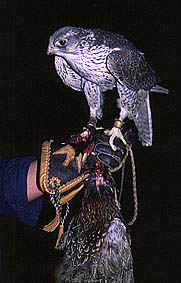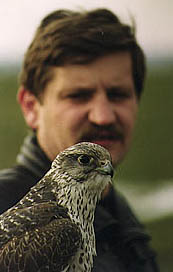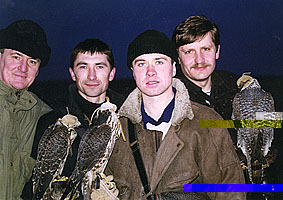Gyrfalcon
Mykola Rud'
Translation in Engl.: Yevheniia Mikheenko
Foto: Mykola Rud;

The Gyrfalcon is a bird surrounded by many legends and was valued highly by many world rulers as recently as the 19th century. The Krechet is the largest representative of the true falcons. Females are larger than males and the bird can reach 55-60 cm in size and 2 kg in weight. Falconers sometimes call the bird a falcon hawk. Eastern peoples give the bird, especially its Altaian species, the ancient name turul. Among falconers in Middle Asia it is also known as schumkar or sunkar. According to H.Dementiev, the geographical name Schunkar or Songor is originates from the root of this word. In many Asian territories (within the borders of former Turkestan) some geographical names also have as their origin the name of this legendary hunting bird (e.g. Schumkarkyj). Europeans call the bird Gyrfalcon.
The Slavonic etymology of the name krechet evidently stems from the Ukrainian verb kresaty, and thus krechet is one who kreshe – suddenly strikes a forceful glancing blow with a loud noise or causing sparks. According to falconers this is how the Gyrfalcon strikes its prey, the sound reaching the earth even from a considerable height. In the Grinchenko dictionary we find a vivid expression: “The oxen, like falcons, kreshut’ their horns”, which clearly illustrates that it is the falcons who kreshut’ – stun their prey with a sudden forceful stroke. The Gyrfalcon, as the largest of falcons, is capable of the most powerful blow – however it is a glancing stroke rather than a direct one.
In the well-known work of M. Menzibr, published in 1910, three forms of Gyrfalcon are described: White or Polar (Hierofalco candicans), Icelandic (H. Islandicus) and Norwegian (H. gyrfalco). Although the generally accepted taxonomy is somewhat different from the ornithology given by the author, the mentioned forms are seen as a single species. Still, they are often mentioned in amateur falconery literature as distinct species.
From the dawn of time the Gyrfalcon was the most valuable hunting bird. Hunting with it was a great honour and pleasure reserved only for the very wealthy, the monarchs or renowned military commanders. A well-known historical fact described in literature is the presence of an image of the black Altaian Gyrfalcon on the shield of Attila, the Scythian king. Doubtlessly this can be seen as one of the first heraldic state symbols of the Scytho-Slavonic peoples. Attila’s empire reached colossal dimensions, stretching east to the Volga, west to the Rhine, north to the islands of the Dutch archipelago and south beyond the Danube, and was distinguished by an exceptionally high level of military discipline.
According to written sources from the East the price of a well-trained Gyrfalcon was equivalent to the price of an Arabian thoroughbred. White birds were always highly priced, being the pride of their owners and the dream of falconers around the world. It is documented that the Duke of Burgundy, after his last crusade and defeat under Nicopolis, ransomed from Turk captivity his son and twenty-four other knights for twelve Gyrfalcons and 200 thousand ducats. Knowing that the Duke could provide the falcons, the Turkish Sultan Baiazet I would not accept any other equivalent compensation in money or goods. The price of Gyrfalcons in regions where falconry is traditional was still very high even in the early 19th century. Kazakhs of Orenburg were known to give three good horses for one bird.

As noted by H. Dementiev, the hunting style of the Gyrfalcon somewhat differs from that of other falcons. Compared to a Peregrine it has shorter casts at the prey and thus loses much less in height in an unsuccessful attack. Characteristic of Gyrfalcons are attacks of such force that a duck can be disemboweled in flight and even such an excellent flyer as the Kite may lose six or seven wing-feathers. The Gyrfalcon is capable of long pursuits of prey, making up to 70 attacks. Unlike the Peregrine, the Gyrfalcon never takes its prey in flight but rather brings it to the ground. This is why from ancient times a Gyrfalcon was flown with a well-trained dog capable of quickly finding and retrieving game. This is also important as a Gyrfalcon can pursue its prey for up to ten miles. Thus, it was also vital to hunt not only with a dog but on horseback or on a camel, as is common among the Arabs. In today’s world these animals are easily replaced by motor vehicles.
Raising and training a Gyrfalcon is much more difficult than other falcons or hawks. This has been noted by many falconers - the birds’ character is firm and stubborn. The full period of training often takes a month, and the falconer’s effort is not always rewarded. This is why the period of “keeping”, accustoming the bird to the hood and later to hunting with a dog and a horse requires a lot of time and patience, as well as thorough knowledge of methods and practical skills.
References to Gyrfalcons are of a considerable interest to the historians as they can, directly or indirectly, provide information about the economic, political and military links between countries in the past. The references to these birds in historical sources are evidence of the level of diplomacy in those times, and can give an idea about the communication of famous historic figures, thus providing crucial data for researchers. The analysis of such information can enable historians to make some important conclusions.
It is known from written sources that Henry II hunted with a Norwegian Gyrfalcon in Pembroke in 1172. Abul’hazi Bekhadur records the precious gift of birds of prey named schumkar to the Chingis-khan by the Kirghiz khan Urus-Inal in 1200. The author of this report clearly states that in Kyivan Rus the bird was known as krechet. Also, it was noted that the birds were white and thus were of great value. The children of Chingis-khan Dzhahataj and Ohodaj who hunted with birds called turul, i.e. Gyrfalcons, apparently sent 50 camels loaded with swans brought down by the birds to Samarkand to be distributed among the public. Strange as it seems, an indirect proof of the fact can be found in the “History of Tamerlan” by Ali Schereffeddin. It says that at the beginning of winter Tamerlan journeyed to Bykhara, where thousands of birds, among them many swans, were gathered at the lakes. Beaters brought by local authorities from neighbouring villagers raised the birds from the water by the sound of tulumbas – special drums. It is likely that turul were cast at the birds as they took off.
In 1236, Edward I received eight gray and three white Gyrfalcons from Norway. Four of the gray birds, trained to hunt herons and cranes, were presented to the Castilian king. In an accompanying letter Edward I said he regretted being unable to send white Gyrfalcons, as he had recently lost nine, and hoped to receive more birds he sent for to Norway.
In 1280 Kublai-khan received white schumkars as a gift from Kirghizs. Also interesting is the letter of khan Dzhemaleddin to the Indian Sultan Maabera in 1300 in which he begs to be excused for not sending Gyrfalcons as they inhabit only northern regions and cannot adapt to the southern climate. In 1384 the khan of the Golden Orde Tokhtamysh sent seven Gyrfalcons as a gift to the Egyptian sultan. Khans of the Golden Orde also presented Gyrfalcons to Tamerlan, receiving the birds from Kyivan Rus and its subordinate lands. Also preserved is the record of Tamerlan sending some Gyrfalcons to the Egyptian Sultan in 1402.
In the wild the Gyrfalcons’ behaviour amazes observant specialists. Especially stunning is the incredibly coordinated co-operation of two birds against their prey. The pair hunting is, as a rule, successful. Very few people are lucky enough to see such hunting in the wild, so a fragment of the description of the scene deserves quoting. This is how an unsuccessful attempt of two birds is depicted by V. K. Orlov in his book “Following the White Gyrfalcon” (“Za belym krechetom”): “One of the Gyrfalcons flew low above the river, forcing the scared birds to take to wing. The other waited in the height, ready for attack. At this moment nature stood motionless. Not a single bird was in the sky. The large silvery gulls, known for their gangster character, seemed fused to the water. The first Gyrfalcon attacked one of the birds, hanging above it in mid-air, formidable talons outstretched. It would not move. The beater Gyrfalcon, unable to rouse the gulls, continued low along the river. We saw as, further on, circling above trees, it started to attack the frozen with fear ravens. One of them it almost pushed from the tree-top, challenging to a fight. Yet the ravens clung to the branches and would not fly up…”
The Gyrfalcon, more than other falcons, is capable of winning a mid-air battle with a heron. This quality of hunting Gyrfalcons is noted by M. Menzibr in his works. In hand-written household and culinary books for women, which even in the times of Kyivan Rus were in almost every Ukrainian house, were given numerous recipes for dressing feathered prey, and, characteristically, herons hunted by trained falcons. A falcon capable of bringing down a heron was seen as very well trained, the evaluation being based on the capability of a heron not only to effectively withstand a Gyrfalcon, but even to strike fatal blows with its beak or feet.

From ancient times, when evaluating
the quality of a Gyrfalcon’s casts,
the height from which the bird
is able to attack is as important
as the number of attacks
it is capable of.